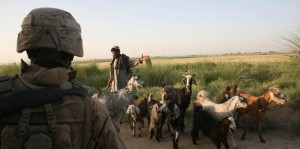Are the Taliban Really on the Brink of Defeat Part II?
BY Herschel SmithIn Are the Taliban Really on the Brink of Defeat? the contradictory claims of progress and resurgent violence in Afghanistan were examined within the context of the NATO organizational structure. On the other hand, no coverage of the Marine operations in the Helmand Province has been as extensive as at The Captain’s Journal with our category Marines in Helmand. The Marines are having great success, of course. But we weighed in on the first subject by stating that the British had exaggerated the imminent defeat of the Taliban. Counterinsurgency takes force projection, and that, for a protracted period.
But are these two claims contradictory? Since Glenn Reynolds linked the first post at Instapundit there was some interest in the subject. Roger Fraley linked this post and caught on to the potential contradiction, and Noah Shachtman with Danger Room published his similarly themed article Who’s Up in Afghanistan? (several hours after The Captain’s Journal, by the way). Noah points out:
Of course, this doesn’t have to be a binary choice. The Taliban could be causing more mischief, and the Marines may be kicking their asses.
Well yes, but more to the point, we should be seeing this as the difference between the micro- and macro-counterinsurgency level. The Marines are not, after all, deployed all over Afghanistan. They are in a troublesome province, to be sure, but they are only in Helmand, and then only in and around Garmser. There is an MEU of around 3200 (the 24th MEU), not all of which is deployed in Garmser (some are engaged in training the Afghan forces and other things).
If we want to consider things on a macro-counterinsurgency level, the McClatchy bloggers link a source called Nightwatch, and opine on Afghanistan as follows:
But now listen to John McCreary, a former senior intelligence analyst for the Joint Chiefs of Staff who compiles NightWatch, an insightful analysis by a veteran professional of daily international developments drawn from open, unclassified sources. His take today on Afghanistan paints a far different – and gloomier – picture.
According to McCreary, May saw more violence than any other month since the 2001 U.S. intervention that toppled the Taliban and forced Osama bin Laden and his followers to flee into Pakistan. He says there were 214 violent incidents in more than 100 of the country’s 398 districts last month. That was up from April’s count of 199 violent incidents in 86 districts.
Writes McCreary: “Despite official efforts to spotlight improvement, the spring offensive this year is far worse than last year’s spring offensive. The security situation has deteriorated again. At no prior time has the Taliban managed to stage attacks in over 100 of the 398 districts.”
“If Taliban fighters are heading to Pakistan, they are going back to base to rest and to get more ammunition and supplies,” he concludes.
In other words, even though there are now more U.S. and ISAF troops than ever before – about 50,000, including 33,000 Americans – Afghanistan may be on track to seeing its bloodiest year yet since the U.S. intervention.
Now, McClatchy is horrible, horrible, horrible, and always biased and colored in the way they see and present the so-called news they publish. The picture they present is worse than the conditions on the ground, because the Marines really are having outstanding success in Helmand. After all, they are Marines.
There are two things that we just hate here at The Captain’s Journal. First, we hate presentations of the situation that are rosier than the conditions on the ground, made that way for the purpose of justifying the campaign. In our opinion, the campaigns (in Iraq and Afghanistan) need no justification, and we don’t waste time by debating six year old decisions. Next, we hate presentations of the situation that are more bleak than the situation on the ground is, made that way for the purpose of undermining the very campaign we should be attempting to win.
The Captain’s Journal loves the truth, and presents critical analysis for the purpose of examination of strategy, tactics and logistics. We do not engage in political ‘hackery’, and we don’t shill for politicians or political parties. The campaign in Afghanistan is suffering from lack of force projection. The campaign in Afghanistan must be won. The Marines are showing us how to win it. These are not contradictory points, and our articles on this have made perfect sense.






